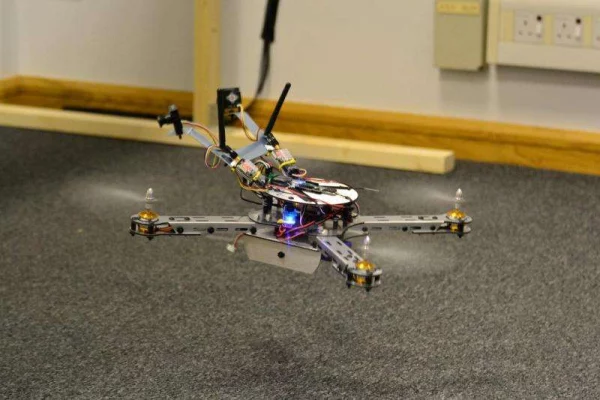The brain of a bee, despite its small size, is one of the most complex biological achievements in nature. With its ability to perceive and flexibly respond to its environment, bees not only perform simple tasks such as flying and foraging but also engage in sophisticated processes like pollination, mating, and protecting the hive. This makes their brain an ideal model for scientists to study, aiming to better understand how biological systems work and how these principles can be applied to modern technology.
A recent study has drawn attention to the replication of the bee brain to pilot a drone. According to a report by BBC News (2023), researchers at the University of Queensland successfully applied a simulated bee brain to a standard quadcopter drone. The results showed that the drone could autonomously perform several flight tasks without human assistance. This represents a breakthrough in the field of robotics and autonomous control.

“Although the bee brain is small and simple, it has the capacity to process complex information to control behaviors like flying, pollination, and protecting the hive. This simulation has allowed drones to perform basic tasks without requiring human intervention.” (BBC News, 2023). This demonstrates that, while the bee brain lacks the complex thinking abilities of humans, it can still provide valuable insights into organizing and controlling biological and robotic systems.
This research, conducted by scientists at the University of Queensland, Australia, was published in the Journal of Robotics and Autonomous Systems in 2023. According to the study, the team employed advanced technologies such as decision theory, neural modeling, and parallel computing to simulate the bee brain. Basic olfactory and visual systems were integrated into the drone, enabling it to recognize and utilize patterns similar to how bees use natural landmarks for navigation.
“The research team successfully implemented the bee’s cognitive model into drones, allowing them to navigate corridors and recognize patterns for autonomous navigation.” (University of Queensland, 2023). These findings not only offer a fresh perspective on simulating the neural systems of small organisms but also pave the way for potential developments in autonomous robotics with applications in areas such as surveying, rescue missions, and military operations.
One remarkable aspect of this study is the drone’s spatial recognition capability. Thanks to the simulated bee brain, the drone could identify wall patterns and use them as a navigation method, enabling it to traverse corridors without colliding with obstacles. This technology expands the capabilities of autonomous systems, allowing them to operate independently and efficiently without human intervention.
“Applying bee cognitive models to drone technology opens up significant potential for future autonomous applications, enabling machines to carry out complex tasks without human assistance.” (University of Queensland, 2023)
This advancement not only provides a better understanding of how the bee brain functions but also marks significant progress in robotics research. By learning from small creatures like bees, scientists are gradually expanding the boundaries of autonomous technology while exploring new opportunities to develop intelligent control systems with broad applications across various industries.


HPX24h > Science > The Secret of the Bee Brain: New Technology Enables Drones to Fly Independently
Tagged Articles
Why Do Experts Believe Alzheimer’s Is an Autoimmune Disease Rather Than a Brain Disorder?
Heart and Brain Health: How to Effectively Prevent Cognitive Decline?
Enhancing Memory with Brain Implants: A New Scientific Revolution
Direct Brain-to-Brain Communication via the Internet
Top Reads from This Category
Science
Blood Test: A Breakthrough in Early Detection of Alzheimer’s Disease
Science
Enhancing Memory with Brain Implants: A New Scientific Revolution
Science
Artificial Intelligence Outperforms Humans in Treating Depression
Science
NSF Cuts 168 Jobs Amid Booming Science and Technology: Paradox or Strategic Move?
Science
Regrowing Adult Teeth in Just 9 Weeks: Science Turns the Impossible into Reality
Science
Extinct Black Rhinos Could Make a Comeback with Genetic Technology
Science
Laser Therapy Could Help Regrow Your Teeth – Did You Know?
Discover New Topics
Fitness
Risk of Increased Mortality in Diabetics Due to Prolonged Sitting: A Warning and Action Guide
Health
The Mystery of Newborn Weight: How Does It Progress Each Month?
Fitness
Effective Workout Tips: The Best Full-Body Exercises for Health
Fitness
Muscle Strain During Exercise: Effective Prevention and Recovery Tips
Animals
Unexpected Science: When Seismologists Listen to Underwater Earthquakes and Discover Whale Songs
Science
China’s Hypersonic Jumbo Jet Could Cut Beijing to New York Flight Time to Just 2 Hours
Fitness
Tai Chi: The Secret to Improving Balance and Relieving Pain Effectively
Parenting Tips
Why Do Preschoolers Have the Habit of Nose Picking?
Fitness
Which Exercise Burns the Most Calories? Tips for Choosing and Training Effectively
Science
Recreating the Mouse Brain in a Virtual World: The Future of Neuroscience
Science
Stem Cell Therapy for Lung Cancer: A New Hope Entering Human Trials
Parenting Tips
Excessive Night Sweating in Children – A Normal Occurrence or a Cause for Concern?
Fitness
Cardiovascular Endurance: The Key to Optimizing Overall Health